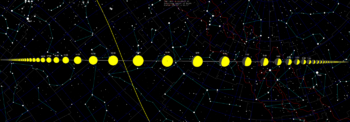Astronomy:2017 VL2
 The orbit of 2017 VL2 and positions on 1 January 2018 | |
| Discovery[1] | |
|---|---|
| Discovered by | ATLAS |
| Discovery site | Mauna Loa Obs. |
| Discovery date | 10 November 2017 |
| Designations | |
| 2017 VL2 | |
| Minor planet category | NEO · Apollo[1][2] |
| Orbital characteristics[1] | |
| Epoch 4 September 2017 (JD 2458000.5) | |
| Uncertainty parameter 7 | |
| Observation arc | (16 days) |
| |{{{apsis}}}|helion}} | 1.5139 AU |
| |{{{apsis}}}|helion}} | 0.9466 AU |
| 1.2303 AU | |
| Eccentricity | 0.2306 |
| Orbital period | 1.36 yr (498 days) |
| Mean anomaly | 337.43° |
| Mean motion | 0° 43m 20.28s / day |
| Inclination | 12.091° |
| Longitude of ascending node | 227.05° |
| 139.41° | |
| Earth MOID | 0.0012 AU (0.5 LD) |
| Physical characteristics | |
| Mean diameter | 18 m (est. at 0.20)[3] 6–32 m (estimate)[4] |
| Absolute magnitude (H) | 26.079[1] |
2017 VL2 is a micro-asteroid, classified as a near-Earth object of the Apollo group. It was first observed by ATLAS at Mauna Loa Observatory on 10 November 2017, a day after it passed inside the orbit of Earth.[2][5]
Orbit and classification
2017 VL2 is an Apollo asteroid, the largest subgroup of near-Earth objects. It orbits the Sun at a distance of 0.9–1.5 AU once every 16 months (498 days; semi-major axis of 1.23 AU). Its orbit has an eccentricity of 0.23 and an inclination of 12° with respect to the ecliptic.[1] It is, however, not a Mars-crossing asteroid, as its aphelion of 1.51 AU is less than the orbit of the Red Planet at 1.666 AU.[1]
Close approaches
The object has a minimum orbital intersection distance with Earth of 180,000 km (0.0012 AU), which corresponds to 0.5 lunar distances.[1] On 9 November 2017, it came within 0.31 lunar distances of the Earth (see diagrams).[5]
Physical characteristics
2017 VL2 has been estimated to measure between 6 and 32 meters in diameter,[4] comparable to the Chelyabinsk meteor, which was also not observed before it hit the atmosphere over Russia in 2013. For an assumed albedo of 0.20, which is typical for the common S-type asteroids, 2017 VL2's diameter would be likely 18 meters only.[3] The size of asteroid 2017 VL2 has been described as that of a whale.[6][7]
As of 2018, no rotational lightcurve of this asteroid has been obtained from photometric observations. The object's rotation period, pole and shape remain unknown.[1][8]
Numbering and naming
This minor planet has not yet been numbered by the Minor Planet Center and remains unnamed.[2]
References
- ↑ 1.0 1.1 1.2 1.3 1.4 1.5 1.6 1.7 "JPL Small-Body Database Browser: (2017 VL2)". Jet Propulsion Laboratory. https://ssd.jpl.nasa.gov/sbdb.cgi?sstr=3789141. Retrieved 8 February 2018.
- ↑ 2.0 2.1 2.2 "2017 VL2". Minor Planet Center. http://www.minorplanetcenter.net/db_search/show_object?object_id=2017+VL2. Retrieved 8 February 2018.
- ↑ 3.0 3.1 "Asteroid Size Estimator". CNEOS NASA/JPL. https://cneos.jpl.nasa.gov/tools/ast_size_est.html. Retrieved 7 February 2018.
- ↑ 4.0 4.1 "A huge asteroid zoomed terrifyingly close to Earth and Nasa didn't see it coming" (in en-GB). Metro. 2017-12-08. http://metro.co.uk/2017/12/08/asteroid-2017-vl2-zoomed-terrifyingly-close-earth-nasa-didnt-see-coming-7144051/.
- ↑ 5.0 5.1 "Asteroid 2017 VL2 close approach – International Asteroid Warning Network" (in en-US). http://iawn.net/2017/11/14/asteroid-2017-vl2-close-approach/.
- ↑ Hamill, Jasper (2017-12-08). "A huge asteroid zoomed terrifyingly close to Earth and Nasa didn't see it coming" (in en). https://metro.co.uk/2017/12/08/asteroid-2017-vl2-zoomed-terrifyingly-close-earth-nasa-didnt-see-coming-7144051/.
- ↑ "Astronomers launch new asteroid-classification system based on animal sizes" (in en-GB). 2022-03-31. https://physicsworld.com/astronomers-launch-new-asteroid-classification-system-based-on-animal-sizes/.
- ↑ "LCDB Data for (2017 VL2) – Not in Data Base". Asteroid Lightcurve Database (LCDB). http://www.minorplanet.info/PHP/generateOneAsteroidInfo.php?AstInfo=0%7C2017+VL2. Retrieved 7 February 2018.
External links
- MPEC 2017-V67 : 2017 VL2 minor planet center
- 2017 VL2 at NeoDyS-2, Near Earth Objects—Dynamic Site
- Ephemeris · Obs prediction · Orbital info · MOID · Proper elements · Obs info · Close · Physical info · NEOCC
- 2017 VL2 at ESA–space situational awareness
- 2017 VL2 at the JPL Small-Body Database
 |



